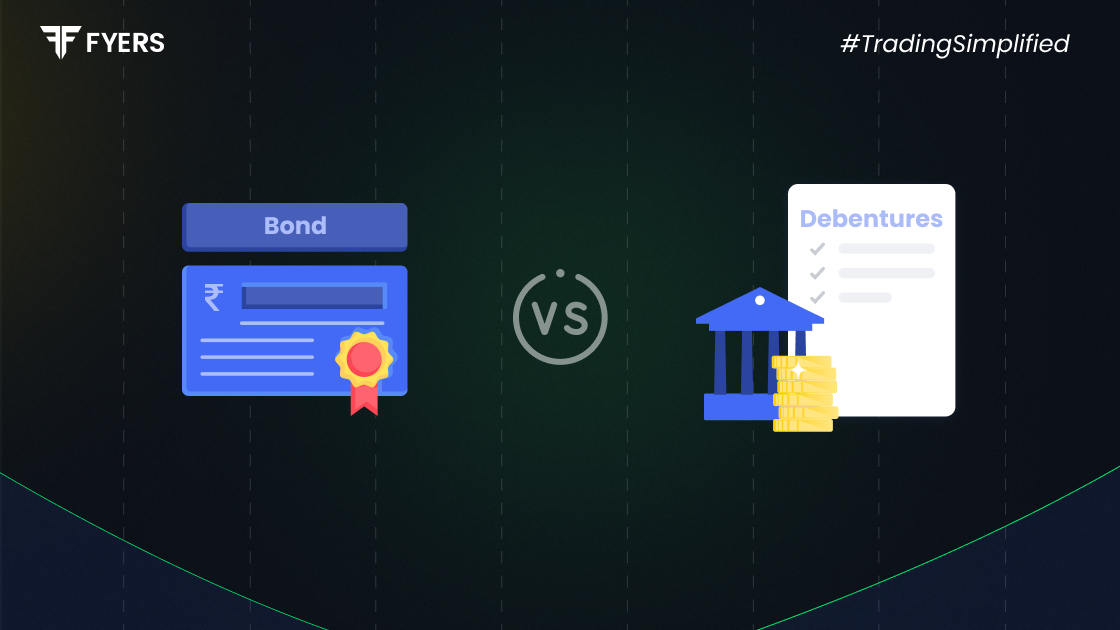

 31 Jul, 2025
31 Jul, 2025
 4 mins read
4 mins read

Investing in fixed-income instruments can help investors maintain financial stability and earn predictable returns. Two commonly used tools are bonds and debentures. While they are both types of debt instruments, they differ in terms of security, regulation, risk level, and ideal investors.
Understanding the difference between bonds and debentures helps people choose the right option based on income needs and risk profile. This article explains what bonds and debentures are, compares them side by side, and explores who should invest in each.
Bonds are financial instruments used by governments, public sector units, or large corporations to raise capital. When someone buys a bond, they are lending money to the issuer. In return, the issuer promises to pay interest at fixed intervals and return the original amount when the bond matures.
Fixed maturity periods, such as 5, 10, or 20 years
Regular interest payments
Usually backed by government guarantees or the issuer's assets
Generally lower returns compared to equities, but more stable
Tradable on exchanges or in the bond market
Types include zero-coupon bonds, inflation-linked bonds, and floating-rate bonds
Bonds issued by governments follow RBI guidelines
Corporate bonds must follow SEBI regulations under the Issue and Listing of Non-Convertible Securities Rules
Certain bonds may qualify for tax benefits under Section 80CCF or Section 10 of the Income Tax Act
Sovereign Gold Bonds, issued by RBI
State Development Loans, issued by state governments
In summary, bonds are low-risk instruments best suited for individuals seeking safe and predictable income.
Debentures are also debt instruments, but they are mostly issued by private companies. Like bonds, debentures involve lending money to an issuer in exchange for regular interest payments. However, debentures are often unsecured, meaning they are not backed by physical assets.
Investors rely more on the company's reputation and credit rating. Because of the higher risk, debentures offer higher interest rates than bonds.
Usually unsecured
Higher interest rates than bonds
May be convertible into equity shares
Issued by private companies
Often privately placed with institutional investors
Interest may be paid quarterly, semi-annually, or annually
|
Type |
Description |
|---|---|
|
Convertible |
Can be converted into company shares |
|
Non-convertible (NCDs) |
Cannot be converted into shares |
|
Secured |
Backed by company assets |
|
Unsecured |
No asset backing |
|
Registered |
Ownership recorded by issuer |
|
Bearer |
Transferable without registration |
NCDs by Tata Capital
Debentures issued by L&T Finance
Debentures are suitable for investors seeking higher returns and who can accept moderate risk.
This table highlights key differences between bond and debenture features.
|
Factor |
Bonds |
Debentures |
|---|---|---|
|
Security |
Usually secured |
Mostly unsecured |
|
Issuer |
Government or large corporations |
Private companies |
|
Risk Level |
Lower |
Higher |
|
Interest Rate |
Moderate |
Higher |
|
Convertibility |
Usually non-convertible |
May be convertible |
|
Regulation |
Strictly regulated |
Comparatively flexible |
|
Ideal For |
Conservative investors |
Those with higher risk tolerance |
|
Listing |
Often listed on exchanges |
May or may not be listed |
|
Taxation |
Interest is taxable |
Interest is taxable |
Knowing these details helps investors decide between the two instruments based on their financial goals and preferences.
Both instruments serve specific roles in financial planning. Choosing one depends on an investor's income goals, risk appetite, and timeline.
Bonds
Suitable for retired individuals or those focused on capital safety
Good choice for stable and predictable income
Ideal for conservative portfolios and diversification
May qualify for tax savings under government schemes
Debentures
Suitable for investors who can accept moderate risk for higher returns
Preferred by those looking for periodic income with possible equity conversion
Can offer income along with capital appreciation
Often used by institutions seeking higher yield alternatives
Before investing, it is important to consider credit rating, interest rate, maturity period, and the issuer's financial health. Also check liquidity, as some debentures may be harder to sell.
Understanding the difference between bonds and debentures is important for making informed investment choices. Bonds provide safety and reliable income and are best for conservative investors. Debentures offer better returns but come with slightly higher risk, especially when unsecured.
Whether exploring what are bonds, what are debentures, types of debentures, or deciding who should invest in bonds, investors should match their choices with financial objectives, risk levels, and investment timelines.
The key difference lies in security and issuer type. Bonds are usually secured by the issuer's assets or backed by government guarantees and are commonly issued by governments and large corporations. Debentures are typically unsecured and issued by private companies relying on creditworthiness rather than asset backing.
Bonds are generally safer because they offer asset-backed security or government support. Debentures carry higher risk since they are often unsecured and depend on the issuer’s financial strength and credit rating.
Debentures usually offer higher returns to compensate for their increased risk. Bonds provide more stable but modest returns, which makes them more attractive to conservative investors.
Yes. In India, interest income from both bonds and debentures is taxable according to the investor’s income tax slab. Certain government bonds may qualify for exemptions under specific sections of the Income Tax Act.
Calculate your Net P&L after deducting all the charges like Tax, Brokerage, etc.
Find your required margin.
Calculate the average price you paid for a stock and determine your total cost.
Estimate your investment growth. Calculate potential returns on one-time investments.
Forecast your investment returns. Understand potential growth with regular contributions.